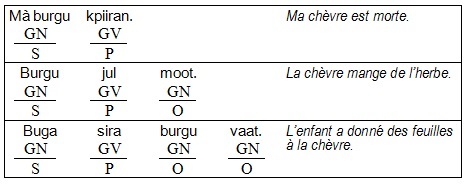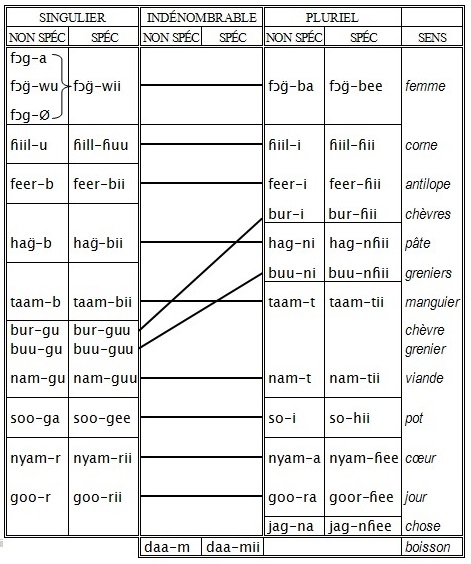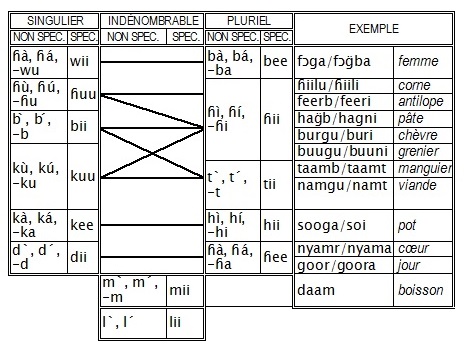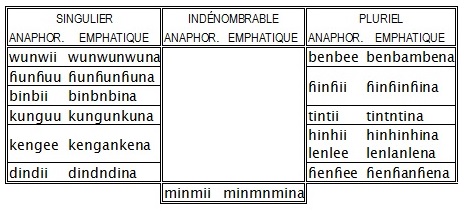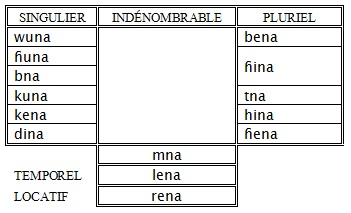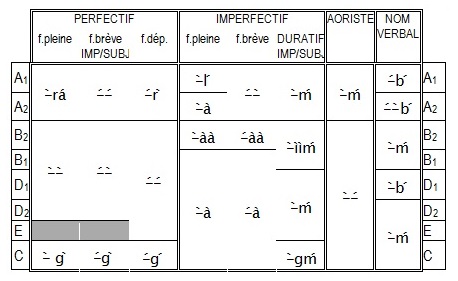Grammar
It is helpful to know the lexicon of a language. But, if that knowledge is not associated with the grammar of the language, understanding the lexicon will be superficial. The grammar allows you to understand how the lexical items are organized to produce meaningful communication. In addition, grasping the grammatical concepts is essential for the language to be used.
This grammar sketch includes foundational concepts regarding the orthography and syntax of the Nawdm language.
The following sections give the reader an understanding of the dictionary entries and how they are used in context of the language and culture. This is organized by number in an annex for the dictionary.
1. The syntax
The syntax of a language involves the system of word order in clauses and phrases specific to that language. In Nawdm, there is variety in syntax governed by rules of order, the knowledge of which proves a high understanding of the language, whether spoken or written. Considering the “sentence” as being the main element of syntax, we will discuss its basic form and also highlight its grammatical elements.
1.1. The simple sentence and its elements
There are two types of sentences in Nawdm: the verbal and nonverbal sentence. The nonverbal sentence consists of just one or two elements: a noun or an adverb and a copula. The following examples are nonverbal sentences.
Burgun.............. It is a goat.
Kpaalaa nnii........ That is all.
Concerning the verbal sentence, it can be simple or complex. When it is simple, it consists of a verb functioning as the predicate. It is usually preceded by a nominal element functioning as the subject is frequently followed by one or more nominal items functioning as objects.
The verbal sentence may consist of a verb that may be accompanied by words that give additional information such as time, place and manner.
Mà burgu kpiira dindiin. .......... My goat is dead. hier.
Burgu jul moot taa kankaa. ..... The goat eats the grass. derrière chez nous.
Buga sira burgu vaat hɔm. ...... The child gave the grass to the goat in great amount.
1.2. The complex sentence with conjunctions
The complex sentence in Nawdm consists of coordinating or subordinating conjunctions between two or more clauses. We will distinguish these two types of complex sentences.
1.2.1. Subordinate clauses
The subordinate clause is characterized by a subordinating conjunction preceding the subordinate clause. The subordinate clause follows the main clause, and is indicated by the conjunction na que:
 The subordinate clause can precede the main clause, and is preceded by the conjunction ka si :
The subordinate clause can precede the main clause, and is preceded by the conjunction ka si :
1.2.2. Coordinating clause
The coordinate clause is characterized by one of the following coordonating conjunctions, which serve to link the clauses together: n, t, ka, n ka and t ka.
Besides these coordinating conjunctions listed, Nawdm also has alternate conjunctions: laa and laa … le.
Ĥà nyira daam n jum diit. ............. He drank some of the beverage and ate some of the food.
Ĥà nyira daam, wii t jum diit. ........ He drank some of the beverage, and he ate some of the food.
Ĥà nyil daam ka ku hɛruɦ’. ............ He drinks from the beverage to be drunk often.
Ĥà nyira daam ka ba di diit. .......... He drank some of the beverage without eating food.
Ĥà ba nyi daam, wii t ka ju diit. .... He did not drink the beverage and he ate the food.
¿ Ĥà bawran laa, bà sira-wu le ?.... Did he steal or was he given a gift?
Certain of these coordinating conjunctions appear not only between two propositions as just mentioned, but also between two noun phrases, as in the following examples:
Ĥá fɔg̈wu n ɦà bii san kpam. ......... His wife and his children went to the fields.
Mà yandaa san kpam laa yaku. ..... My uncle went to the fields or to the market.
2. Grammatical categories
In general, a category is a class in which we collect similar objects, persons, actions, etc.
In grammar, a category is a set of terms having similar structure and funstion. Grammatical categories includes nouns, verbs, adjectives, etc. Each of these categories will be discussed.
2.1. Nouns: hidr (h.)
A noun can be a living thing, an abstract idea or a physical object. In the Nawdm dictionary, nouns are generally in their singular form as the headword, accompanied by the plural form marked by pl., for example: rond, pl. rona, yam. Certain nouns, however, which occur normally in their plural form, are entered under that form, accompanied by the singular form marked by sg., for example: namt, sg. namgu, meat. There are a few nouns in Nawdm that do not have a singular form (for example nyeet, darkness, obscurité) and a few that do not have a plural form (for example muunu, sun).
In the dictionary, after the headword of the entry is followed by the pronunciation, then the plural form (Pl.), or eventually the singular form (Sg.), the class pronouns are given, for example:
L’abbreviation h. ka/hi indicates that the word is a noun (h. = hidr) and that the class pronouns are ka au singulier et hi in the plural.
The noun can designate an individual (for example : Maroba) or a specific place (for example : Nyamtgu). These are proper nouns that are always written with a capital letter. Nouns can also be other things that pertain to the same category (for example: people, trees, birds…). Nouns are for distinguishing one thing from another in the culture.
In Nawdm, the nouns are characterized by their functions and their structure.
2.1.1. The functions of nouns
Nouns can assume diverse functions in the sentence.
- Subject
Kɔrga tɔɦl malɦa. ....................... The chicken pick corn.
- Object
Baaba kura kɔrga. ...................... Papa killed a chicken.
- Circumstance
Ĥà ree fuut kɔrgan. .................... He pulled out the intestines from inside the chicken.
- Supplementing
Kɔrga taagr kaɦdgn. ................... The thigh of the chicken is broken.
- Completed
Huraa kɔrga bɔdan. .................... The chicken of the chief is lost.
- Qualified
Kɔrfeelga ɦogaan. ...................... The chicken is white smoldering.
- Predicate
Kɔrga nnii. ................................ It is a chicken.
2.1.2. The structure of the noun
In nawdm, the noun has the following structure:
Lexical base + Class suffix
The class suffix characterizes the identity of the noun relating to other grammatical categories.
2.1.2.1. The class suffixes
All the nouns in Nawdm have agreement, whether they are singular or plural. These nouns that have specific agreement belong to the same class. The class suffixes are displayed in the following table. Each suffix is separated from its root by a hyphen, which does not play a role in the orthography.
The class suffix serves as a determiner for the nominal root. The class suffix is an identifier and the root is then the identified. Information contained in the suffix is specific or nonspecific, number, and possibly semantic information of derivation.
2.1.2.2. The nominal root
The nominal root is the central part of the noun that carries the meaning. It can be simple, with only a root, or complex, consisting of more than a root. Complex base forms are of two types, derived base forms consisting of a root and a derived suffix, and compound bases consisting of two or more roots, or a root and a derived base.
riidgu (rii- + -d- -gu)..................................... Rubber bucket (to get water + agent) derived
baŋkpaam (baŋ- + kpaa- -m).......................... Red oil (palm tree + oil) compound (root + root)
baŋkpurkpaam (baŋ- + kpur- + kpaa- -m).......... huile de palmiste (palm tree + nut + oil) compound (root + root + root)
dakuuda (daa- + kuu- + -d- -a)...................... ivrogne (beverage + kill + agent) compound (root + derived)
2.2. Pronouns: hidr tɔgiitgu (h.t.)
Nawdm has several types of pronouns: personal pronouns and class pronouns; reciprocal pronoun, demonstrative pronouns, indefinite pronouns, manner and spatial-temporal pronouns.
2.2.1. Personal pronouns
Personal pronouns distinguish the two participants of a discourse, that is, first person or locative pronoun, which refers to the person who is speaking, and the second person or illocative pronoun, referring to whom someone is speaking. These pronouns can never assume the function of completed, which are determined by class pronouns.
The personal pronoun is characterized by 1st, 2nd person, the number (singular or plural) and the degree of determination.
1. The simple form corresponds to non specific values. Depending on the tonal context, the tone is high or low. Subject pronouns (to the left of the verb) and possessives (to the left of the noun) are always written in the orthography with their tone as separate words. Object pronouns (to the right of verbs) and vocatives (to the right of the noun) are always joined in the orthography to the word in question by a hyphen. In subject position, the 2nd person pronoun can be reduced to its tone.
Ka má kwe namt, mà si-v. ................ If I cut some of the meat, I will give some of it to you.
Ka mà kwe namt, mà daan. ............... If I cut (past) the meat, I will come.
Buga-v ! ....................................... You, child.
Tˋ sira-n diit. .................................. We gave you some food.
(ˋ) Soɦdg-ma hɔm. .......................... You received me well.
2. The anaphoric form refers to a person previously introduced. It corresponds somewhat to what one would express in French by "me who speaks to you, I … »
Maa kpaa mi tintii. ................. Me who speaks to you, I do not know anything about this matter.
¿ Nii bɔɦɔɔ-ma tet ? ............... You who are there, what are you saying to me?
3. The emphatic form corresponds to the conjugation of the specified form. It can be used to focus on the person speaking. It is also used in the second person as a vocative pronoun (used to call out or question), and in the first person plural of the imperative.
Man lee, mà kpaɦ mà bee. ........... As for me, I will not be able to.
Ven ! Daan waa ! ....................... You, come here.
Tn ked-n ! ................................ Let’s go!
Emphatic pronouns have, like the noun, a special form when followed by another verb complement, a form obtained by adding the suffix –wu.
Ĥà sira manwu daam. ................... To me, he gave the drink.
The second person singular pronoun can take the value of singular indefinite human, especially in procedural texts.
Ka vˋ mɔɦ haar, lˋ ba na vˋ kpogl want saɦ’. .... When one builds a house, first one must gather the materials.
2.2.2. Class pronoms
The class pronouns correspond to that which traditional grammar calls third person. They agree with the noun that they represent. When the class is unknown or when the words of different classes need to be represented by a pronoun, we use the neutral pronoun from class 1. This pronoun is used like all the others. In object position, however, only the specific form may be used.
Regarding personal pronouns, the tone of class pronouns vary according to their tonal context. When they function as a subject pronoun (to the left of the verb) or possessive (to the left of the noun), they are written in the orthography with their tone as separate words. But for object pronouns (to the right of verbs), they are joined by a hyphen. When they are appropriatives or interrogatives (to the right of the noun), they are separated from the noun by the appropriative morpheme “re” or the interrogative morpheme “te” to which they are connected in the orthography. The class interrogative “ɦa” singular does not exist, it is replaced by the form “wen” used also for personal pronouns. The neutral pronoun has neither an appropriative form nor an interrogative form.
2.2.3. The reciprocal pronoun
In order to show that the action expressed by the verb may be done by the subject to the object as well as by the object to the subject, the reciprocal pronoun is used. It is also used when the persons mentioned have something in common. Note that it is a unique pronoun form (taa).
Bà lagii taa bà sumii. ....................... They exchanged plates..
Taa scklb ba hɔm. .......................... Mutual love is a good thing.
Kpakpant keda taa kaa. ................... The ducks march one after the other.
2.2.4. Demonstrative pronouns
The demonstrative pronouns agree with the noun which they replace. There are two forms of demonstratives: anaphoric, indicating that the person or object in question has already been introduced and are further shown; and emphatic. In the latter type, the emphasis is on showing the object. In addition to these pronouns, the demonstrative adjective is pronominal.
¿ Mà fidaa tugteku ? .................................. Which shirt should I where?
Kunguu ba nakakeet, fid kungunkuna ! ........... This one here is dirty, wear that one there.
2.2.5. Indefinite pronouns
There are several types of pronouns used with the indefinite sense according to the idea that you wish to express:
- ba (plural class pronoun) for people
- l, lii (non class neutral pronoun) for non humans
- bii (singular class pronoun) for tangible things
- tii (plural class pronoun) for non tangible things
Examples:
Bà sira-wu daam. ........................ Someone gave him a drink.
Lˋ ba ɦe bii. ................................ That does not matter.
Bii dama dugun. .......................... Something is moving in the room.
Tii nnii. ...................................... It is that one.
Lˋ ɦera-ma lii. ............................. That is helpful to me.
In addition, the following particle “baa” can occur with interrogatives to form indefinite pronominal phrases:
baawena. ..................................... anyone
baaben. ....................................... anything
baatee. ....................................... anywhere
2.2.6. Manner pronouns
There are two pronouns of manner: the assertive pronoun “welee” that contrasts with the interrogative pronoun “laa”.
welee. ........................................... Like this! (assertive)
laa. ............................................... How? (interrogative)
Examples :
Ĥà diira welee. ................................. He ate like this.
¿ Ĥà kada laa ? ................................ How is he seated?
2.2.7. Spatial-temporal pronouns
The spatial-temporal pronouns are regrouped according to their common characteristic,
that of replacing a circumstance, either for place (locative pronoun) or for time (temporal pronom).
2.2.7.1. Locative pronouns
Locative pronouns include the following:
 The simple locative pronoun designates any place somewhere; it is also used as a relative pronoun and is placed after a subject of a relative proposition of place without antecedent.
The simple locative pronoun designates any place somewhere; it is also used as a relative pronoun and is placed after a subject of a relative proposition of place without antecedent.
Ĥà kada kan. ............................... He is seated there.
Ĥà kan san ree baa vɔkun. ............. There, where he went, is far.
The specific pronoun indicates a known place, a place already introduced. It is also used like specific pronouns for marking the end of a relative proposition. The pronoun can be reinforced by the simple pronoun.
Ree ba hɔm. ................................ That place there is good.
Reekan ba hɔm. ........................... This place here, precisely this one is good.
Ĥà kan san ree baa vɔkun. ............ There where he went, is far.
The imprecise pronoun indicates the place that is imprecise. It can be reinforced by a simple pronoun.
Ĥà san rii. .................................. He went somewhere.
Ĥà san riikan. ............................. He went somewhere.
The interrogative pronoun can also be reinforced by a simple pronoun.
¿ Goor tee ? ............................... Where did you sleep?
¿ Ĥà goor teekan ? ...................... Where truly did you sleep?
2.2.7.2. Temporal pronouns
The temporal pronouns in Nawdm are as follows:
The temporal relative pronoun is placed after the subject of a relative proposition of time without an antecedent to mark it as such:
Ĥá wen nyan mà kenna lee, n nyab. ..... When he saw that I was coming, he left.
The specific pronoun indicates a known time already introduced. It is also used like specific pronouns to mark the end of a relative proposition. This pronoun can be reinforced by an imprecise pronoun.
Mà san kan, lee, mà ba nyaan bii. ....... I went there, but however I saw nothing.
Man san kan lee, n ka ba nyaan bii. ..... When I went there, I saw nothing.
Leedaa, ɦii da kpaa yoɦ dima. ............. At that time, no one wore the pagne.
The imprecise pronoun daa, indicates a non specified time.
Weem daa bà da kpaa yoɦ dima. ........ In those days during that time in the past, no one wore the pagne.
There are two interrogative pronouns, one for a question referring to a moment of the day; and the other pronoun for a date in time. The pronoun for a moment of the day consists of an interrogative of manner followed by a relative temporal. The second type is composed of a locative interrogative followed by an imprecise temporal.
¿ Ĥà nyab laawen ? ............................. When did he leavei ? (at what moment of the day?)
¿ Ĥà nyab tedaa ? ............................... When did he leave ? (what date?)
2.3. The adjective: hidr beeb (h.b.)
Adjectives are determinants for nouns; this is their function. Certain adjectives have the possibility of substituting for nouns and thus fill specific functions for them.
(see 2.1.1 above).
The adjectives are unique in that they occur in various classes (i.e. omniclasse) in accordance with the noun that they modify. That is what differentiates the adjectives from nouns.
Regarding pronouns, they can in certain cases remplace them. There are five types of adjectives in Nawdm: qualificative, quantatative, indefinite, number and demonstrative pronouns. Additionally, the relative proposition is a proposition can function as an adjective.
In this dictionary, adjectives are entered under their nominalized form.
2.3.1. The qualitative adjectives
The qualitative adjective attaches to the base of the noun, and occurs between the base and the class suffix. This placement requires that the qualitative adjectives form a subclass.
Ils ont pour caractéristique formelle de faire corps avec le nom et de se placer entre sa base lexicale et son suffixe de classe.
fɔgjeena / fɔgjeenba ........... another woman / other women
baarjeenu / barjeeni ........... another broom / other brooms
nyaaljeenm ....................... another water (source)
From a formal viewpoint, the simple qualificative adjectives are distinguished from the derived qualificative adjectives.
The simple qualificative adjectives are composed of a non analyzable root. They form a very limited lexical class and serve to design:
- The fundamental colors:: hool- black, feel- white, mɔl- red ;
- Size and weight : vɔg- high, gigid- court, mɛr- thin, yalm- large, jee- heavy, vɛlii- léger ;
- The physical or moral properties: tul- hot, nigii- cold, too- bitter, dee- sharp, bilm- whole, kilm- deep, hɔm- handsome, good, bɛɦ- bad.
- Age: kpeem- usage, kwɛɛl- new, kpalm- old, biil- ripe, kaa- young, unripe ;
- Sex organ: daa- male, nii- female ;
- Otherness: vol- other (d’une alternative), jeen- other, different.
The derived qualificative adjectives have the possibility of being derived from an adjective lexical base or not. These adjectives can also be the result of an immediate adjectival derivation or a mediate derivation.
- The immediate derivation can be formed
- by reduplication:
sumkwɛɛlga ............... a new plate
sumkwɛkwɛɛlga .......... a completely new plate
- by suffixation from class markers:
Buga ba hɔm. ............... The child is good.
buhɔmga ..................... a good child
- In certain cases both types of derivation (immediate and reduplication) can be found: diira kù biɦ’. ............... They ate it entirely.
burbibiɦgu ...................... a huge goat
- Regarding the mediate adjectival derivation, it can be formed by a lexical base from another grammatical class joined with a derivative, creating an adjectival base. The following are the four derivatives which function to create adjectives:
-kaɦ-, m-, -r- et -ŋ-.
nidhaɦrkaɦba ........... some strong men
kɔrɦɔgmga ............... the broody hen
nidtaɦra .................. the third man
gokwiɦlnd ................ the tenth day
2.3.2. Quantitative adjectives
Quantitative adjectives are strictly separated from the nouns that they modify. They agree with the noun that they modify, as they are composed of an identical suffix. These quantitative adjectives form a subclass of adjectives.
nidba mɛmba .................. all the men
burgu mɛngu / buri mɛni .... the entire goat / all the goats
daam mɛnm .................... the entire beverage
Besides expressing approximate quantities, these quantitative adjectives show specificity.
buga mɔmga / bii mɔmii ..... the same child / the same children
Unlike qualificative adjectives, quantitative adjectives cannot substitute for the noun. It is necessary to indicate at least by a pronoun what the adjective quantifies. The neutral pronoun without a class can serve as this pronoun.
Bà mɛmbee diiran. ........... Everyone ate.
Lˊ mɛnguu diɦn. ............... Everyone finished.
2.3.3. Indefinite adjectives
Indefinite adjectives do not have a root but are formed by the reduplication of the class nominal marker, the first in the form of a specific pronoun and the second in the form of a simple pronoun.
Like the quantitative adjectives, the indefinite adjectives are placed after the noun that they modify and are in agreement.
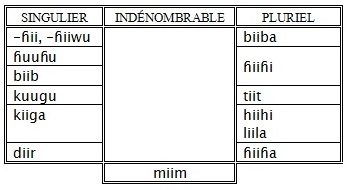 nidɦii / nidba biiba .........a certain person / certain persons
nidɦii / nidba biiba .........a certain person / certain persons
burgu kuugu / buri ɦiiɦi ...a certain goat / certain goats
goor diir / goora ɦiiɦa .....a certain day / certain days
2.3.4. Numerical adjectives
The units from one (1) to nine (9) are expressed by adjectives that have both a cardinal and an ordinal form. The tens, hundreds, and thousands are nouns, which can be accompanied, however, by a derivative that can create numerical ordinal adjectives.
2.3.4.1. The cardinal numeral adjectives
These consist of counting units:
myen.......one
mreɦ........two ...
mnaa.......four ...
mwɛɦ.......nine
These adjectives are separated from the noun that they modify but show agreement with that noun; taking on the form of the class of the noun.
nida ɦayen / nidba bareɦ ....... one person / two persons
burgu kuyen / buri ɦitaɦ ........ one goat / three goats
sumga kayen / sumii hiniind ... one plate / eight dishes
For the tens, hundreds and thousands, they have the form of a noun, without any agreement marker.
 In the following examples, there is no agreement between the number and the noun::
In the following examples, there is no agreement between the number and the noun::
nidba kwiɦr ....... ten persons
buri kwiɦr .......... ten goats
sumii lɛmu ......... one hundred plates
nidba ruugu ...... one thousand persons
But, when the tens, hundreds, and thousands have ones digits, there is agreement between the ones and the noun:
nidba kwiɦr n bareɦ ................................ twelve persons
buri kwiɦr n ɦitaɦ ................................... thirteen goats
sumii lɛmu n kwɛɛrɛɦ n hinu ...................... one hundred twenty-five plates
nidba ruugu n lɛmi ɦitaɦ n kwɛɦnaa n banu .. one thousand three hundred forty-five persons
2.3.4.2. Numerical ordinal adjectives
These adjectives express rank and order. The ordinal numbers from one to nine form a base with the noun that they modify similar to a qualificative adjective that goes between the nominal base and its class suffix. The tens and certain others also agree with the noun.
nidreɦdra / nidwɛɦla ........ the second person / the ninth person
burreɦdrgu / burwɛɦlŋu .... the second goat / the ninth goat
nidkwɛɛreɦa / nidlɛmla ..... the twentieth person / the hundredth person
There is a form among the class suffixes –m which functions as an adverb morpheme. Among the set of words with this form are the numerical adverbs.
reɦdrm / wɛɦlm ................ secondly / ninethly
kwɛɛreɦm / kwɛɦnuum ....... twentiethly / fiftiethly
lɛmlm ............................. one hundredthly
2.3.5. Demonstrative adjectives
As the word indicates, demonstrative adjectives are used to indicate that a person or object is near, that it is within view. In the orthography, each of the demonstrative adjectives follows their noun and carry its suffix. It is linked to the noun by an n that is pronounced differently according to the following consonant. The demonstrative adjectives consist of a prefix which agrees with the class of the noun, and a root. Additionally, there are both temporal and locative demonstratives that occur after a pronoun or a verb, or joined to an adverb.
Nidbanbena ba hɔm. ..................... These people are good.
Burgunkuna ba mɔlgu. ................... This goat is reddish colored.
Daamnmna ŋmiign. ....................... This drink is sour.
Mà ŋmɛtgna gwɛɦmalena. .............. I am coming back in a moment.
Maa mà daan vˋ man didii lena. ...... I will come to your house very soon.
Buga keda rena n rena. ................ The child goes from here to there.
2.4. Adverbs: goweriikaɦgu (g.)
The adverbs are unchangeable words that give precision to the predicate in the phrase, in which they assume a role of details regarding circumstance. Thus, they could provide details regarding the circumstances of manner, time or place. They also have the possibility of assuming the predicate function in a nonverbal phrase, therefore, to constitute the core or central element.
Ĥà diira kɔd. ....................... He ate much.
¿ Kɔd nnii ? ......................... Is it much?
These invariable adverbs, consisting of a morpheme, can be repeated to create a phrase with intensity. For adverbs of more than one syllable, a reduplication gives a similar result. In the dictionary, besides the simple form of the headword, you will find either the repeated or redoubled form. In Nawdm, the adverbs are minimal, creating a very limited class. Here are some examples:
Even though these so called adverbs are few, the adverbial nominals as well as the ideophones have the same function.
2.4.1. Adverbial nominals
The adverbial nominals are provided with the suffix of class D, or, more rarely, with the suffix of class ɦa plural, and function as adverbs.
nawdr .................................. like the Nawdba
fɔgr ..................................... in a feminine manner
tawaɦ .................................. with a start
2.4.2. Les ideophones
Concerning the ideophones, They have the particularity of giving precise information to the verb. Sometimes these provided onomatopoeia effects, having been formed by the sound or phonics of the meaning, by imitating, or recalling or evoking the meaning.
kpaw ................................... boom!
Often, there is no natural link between the meaning and the ideophone, just simply a conventional link.
wasaɦ ................................. very white
kpaalaa ............................... completely
On the other hand, ideophones can be intensified not only by means of an intensifying phrase such as adverbials, but also by an extreme lengthening, either of the final consonant or of the vowel. This form is called the intensive form of the ideophone.
turr ...................................... very firmly
siii ....................................... very bright red
kpaalee ............................... absolutely completely
2.4.3. The adverbial phrases
With the very few number of adverbs, there are two types of adverbial phrases to assist in this function: syntagms of intensity and determinative syntagms. The syntagm of intensity is formed from the reduplication of an adverb. This causes the meaning on the semantic level to become intensification.
Ĥà sol weem weem. .................... He runs very fast.
The determinative syntagma puts two adverbs into play, one of which determines the other.
Ĥà sol weem kpaalaa. ................. He runs really fast.
Ĥà sol weem kpaalaa kpaalaa. ...... He runs truly very fast.
Ĥà sol weem weem kpaalaa. ......... He runs really very fast.
The last two examples show that the determinative syntagm allows for both adverbs to be repeated, but not in the same sentence.
2.5. Verbs: ɦɛb gwɛɛgu (ɦ.gw.) ; beeb gwɛɛgu (b. gw.)
Verbs in Nawdm are distinguished from other parts of speech by their function and structure. All the verbs in Nawdm have a conjugated form that is marked by a suffix. While French verbs are conjugations are based on tense, verbs in Nawdm are conjugated based on aspect. They also distinguish verbs of state (beeb gwɛɛgu) and action (ɦɛb gwɛɛgu).
In the dictionary, the verbs are displayed in their nominal form and are arranged in two groups: verb class -b and class -m.
It is important to note that these verbs are assisted by auxiliaries and particles.
2.5.1. The function of the verb
In terms of function, the verb functions as the central element in the verb phrase, and can function alone in the imperative form.
Mà dig diit. ......................... I prepared the food.
Dig ! .................................. Prepare!
The verb can also become a noun. This is called nominalization; the verb becomes nominalized and functions as a noun (see 2.1.1 below). However, note that the nominalization is not possible in the conjugated form of the verb.
2.5.2. The verb structure
Regarding verb structure in Nawdm, verbs are composed of a lexical base joined by an aspectual suffix.
BASE LEXICALE + SUFFIXE D’ASPECT
2.5.2.1. The verb lexical base
The verbal lexical base can be simple or complex. When it is simple, it is consists of only a root.
Mà diira diit. ....................... I ate the food.
When it is complex, the verb consists of more than a root. The base can be derived, or, in other words, it consists of a root and one or more derivative suffixes. There are two types of derivatives: productive and nonproductive, which in turn can be active and stative. The productive derivatives are directional and indicate of movement or position toward or away from the speaker.
Ĥà ŋmɛtg haaga. ............... He came back to the house.
Ĥà ŋmɛtgn haaga. ............. He came back to the house [the speaker is at the house].
Ĥà ŋmɛtgii haaga. ............. He came back to the house [the speaker is not at the house].
The nonproductive derivatives are varied. To learn more, please refer to a more profound study of Nawdm verbal structure.
Ĥà nyira nyaalm. ............. He drank water.
Ĥà nyilg buga nyaalm. ...... He made the child drink water.
2.5.2.2. Verbal suffixes
The verbal suffixes in Nawdm mark aspect and mode of state or action. Their role is to change the meaning of the verb according to the point of view of the speaker regarding the process of the event. The aspectual suffix determines whether the verb is in the imperfect, perfect, imperative, subjunctive or indicative mode.
2.5.2.2.1. Aspect
In language in which aspect is plays a role, there is a process of an action or state happening independently of time. This allows an action to be completed (completive) or not completed (incompletive). For stative verbs, there is generally only one stative aspect. But, in Nawdm, there is a non marked form for aspect called “aorist” used in dependant clauses.
► a) Perfective or completive aspect
Perfective or completive aspect is recognized by actions that have a definite beginning and end.
Mà nyiran. ........................ I drank.
The perfective aspect could be punctual. When the action is short or long, but is completed, it is considered punctual.
Ĥà toodgn. ....................... She pounded.
In Nawdm, the perfective form occurs in three possible forms: a plain form in an independent or principal clause or in positive mode, a brief form in the negative, and a dependant form that occurs in a dependant clause.
► b) Imperfective or incompletive aspect
The imperfective or incompletive aspect indicates that the action has not been completed, but has just stated (which is called ingressive), or is at the end (which is called terminative), or is somewhere along the process (which is called progressive).
Mà nyiln. ............................. I am drinking.
In Nawdm, the imperfective has three forms: a simple form in the positive, a short form in the negative, and a durative form.
► c) The stative aspect
When an action or a state does not indicate having a start or ending, it is in the stative aspect.
Mà jeɦran. .......................... I am standing.
► d) The aorist aspect
In Nawdm, the aorist form is unmarked for aspect and follows a conjugated form which is marked for aspect. This aspect marker is considered as applying to both forms.
Ĥà nyil n jum. .................... He is drinkiing and eating.
Ĥà nyira n jum. .................. He drank and ate.
Ĥà ba nyi n jum. ................ He has not drunk or eaten.
2.5.2.2.2. Mode
In Nawdm, there are three modes: indicative, imperative, subjunctive.
► a) The indicative mode
The indicative mode shows actions or states that are presented as independent of the wish or opinion of the speaker. The subject is always present in this mode. In Nawdm, the verb is accompanied by an actualizer, which occurs before or after the verb, and serves as a complement, a circumstance, a negation, or a particle of identification.
Ĥà nyira hɔm. .................. He drank well.
Ĥà ba nyi. ....................... He did not well.
Ĥà nyiran. ....................... He drank.
► b) The imperative
The imperative mode indicates that the action or the state must occur. The form is characterized by the absence of an explicit subject. The singular form of the imperative addresses the second person singular. The plural imperative form is marked by a suffix and addresses the second person plural. For the first person plural, the plural imperative is used and is preceded by the first person plural pronoun placed as a vocative apposition. The imperative is marked by a morpheme zero in the positive, and daa in the negative. These morphemes serve as actualizers. The verb occurs in either the brief form (the dependent form for stative verbs), in which case it takes on the perfective aspect, or the durative form of the verb for the imperfective aspect.
Nyi ! ............................. Drink! (perfective)
Nyim ! ........................... Drink! (imperfective = begin to drink, continue to drink, finish drinking)
Daa nyi ! ........................ Do not drink!
Nyim-n ! ......................... You, plural, drink! (imperfective)
Tn nyi-n ! ....................... Let’s drink! (perfective)
► c) The subjunctive
As the title indicates, the subjunctive mode indicates that the action or state is presented by the speaker according to his/her view/wish.
This mode is characterized formally by the brief form of the perfective or by the durative form for the imperfective aspect, and by the presence of the subject.
Moreover, the subjunctive mode marker is displayed as a high tone on the subject pronoun and serves as an actualizer.
Ĥá nyi ! ............................ May he drink!
Ĥá jeɦr ! ........................... May he drink standing up!
2.5.2.3. The verbal conjugations
According to the choice of aspective-modal suffixes, the verbs in Nawdm can be divided into diverse classes. Moreover, all verbs have a nominal form, of either class -b, or class -m.
The diverse verbal classes are displayed in the following table:
In the dictionary, the headword of each verb is the verbal noun. Then the plain perfective form is given along with the plain form of the imperfective and aorist.
2.6. The particles
There are several particles in Nawdm, notably particles indicating time, appreciation, negation, concordance and modulation.
2.6.1. Particles indicating time in Nawdm
The particles of time occur after the subject of a phrase, The first two particles are used in a syntagme of modalization while the last two particles are used in a predicate syntagme.
2.6.2. Particles of appreciation
These particles show appreciation within the whole phrase. This particle creates a statement, and occurs between the subject and the verb.
¿ Ĥà nyi san kan ? .............. Did he go there only one time?
2.6.3. The particles of negation
There are three negative particles in each of the dialects:

In the eastern dialects, there is an additional negative future particle.
Mà ti nyi. ............................. I will not drink.
2.6.4. The particle of concordance
The concordance particle occurs after the particle of time and appears in the predicate syntagmes as it modifies any constituent of the phrase. This concordance particle also occurs in non verbal clauses.
Ĥà ta daɦra nanawda. ......... He also bought sandals.
Ĥà da ta daɦra nanawda. ..... He had also bought sandals.
Ĥà daɦra ta nanawda. ......... He bought sandals also.
Ta ɦà nyan. ...................... She is also his mother.
2.6.5. The particle of concession
The particle of concession occurs with any predicate. This particle is placed after the particle of concession and expresses contradiction.
Ĥà la diiran. .......................... He ate despite it all.
La ɦà fɔgn. ........................... Despite that, she is his wife.
2.7. The auxiliary : tɔrgm gwɛɛgu (t.gw.)
The auxiliaries are derived from verbs or defectives. They provide a specification with respect to the verb and only fill an auxiliary function. The auxiliaries always precede the verb and a pronoun in agreement with the subject, in a structure such as:
This is a structure that is used to express future time. The auxiliaries therefore provide specification regarding the moment, obligation and certitude. They make up a class formed by three different types of elements: the degree of proximity of the realization, the degree of obligation and the degree of certitude of the realization.
2.7.1. The auxiliaries of degree of proximity and realization
- ba / kpaɦ indicates that the process will or will not occur in the near future. The first one can express positive or negative meaning, while the second one will only express a negative.
Ĥà ba ɦà san kpam. ........ He will go to the fields.
Ĥà kpaɦ ɦà san kpam. .... He will not go to the fields.
- daa indicates that the process will certainly happen in the distant future.
Ĥà daa ɦà san kpam. ...... He will certainly go to the fields.
2.7.2. The auxiliaries of degree of obligation of the realization
- ɦe indicates that the subject must accomplish the process.
Ĥà ɦe ɦà san kpam. ........ It is necessary that he go to the fields.
- da indicates that the subject would surely accomplish the process.
Ĥà da ɦà san kpam. ........ He ought to go to the fields.
- saa indicates that the subject ought to accomplish the process even though it was not him whom they thought of initially to do it.
Ĥà saa ɦà san kpam. ....... He will just have to go to the fields (to see the process).
2.7.3. The auxiliaries of degree of certitude of the realization
- kee indicates that everything is progressing toward the realization of the process.
Ĥà kee ɦà san kpam. ...... He will go to the fields.
- gbe expresses a realistic wish that they are not certain that the process will be realized.
Ĥà gbe ɦà san kpam. ...... Provided that he goes to the fields.
2.8. The interjection: diila gwɛɛgu (d.gw.)
Interjections are short words that do not agree with other words (invariable) and that have the particular possibility of independently forming a complete sentence.
Ĥiin ! ................................... Yes!
Ĥaai ! .................................. No!
Hai ! .................................... Pardon me!
From those examples above, we can conclude that the interjections can serve as direct discourse. But, they can, however, form indirect discourse.
Ĥà beda na ɦiin ! ............... He said yes!
They can equally form a phrase that is in apposition to the phrase that follows.
Hai ! Nyaan mà ɦigm ! ....... Pardon me! See, I am in distress!
[1] Nicole, Jacques, 1983, Morphologie du nominal et du verbal en nawdm, langue gur du Togo (Morphology of the nominal and verbal structures in Nawdm, a Gur language of Togo, Thèse de doctorat de 3e cycle, Linguistique africaine, Paris : Université de la Sorbonne Nouvelle (Paris 3), 283 p.

